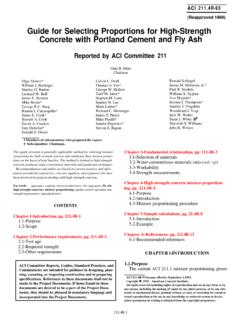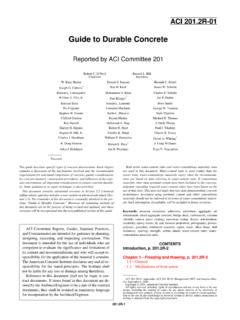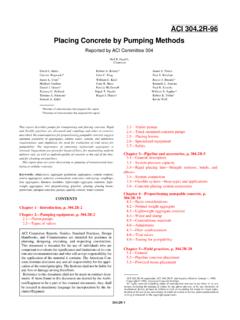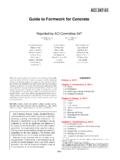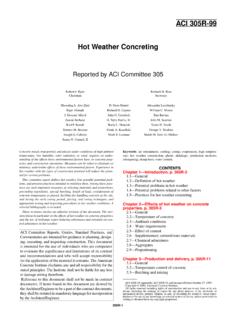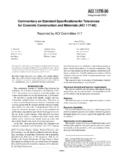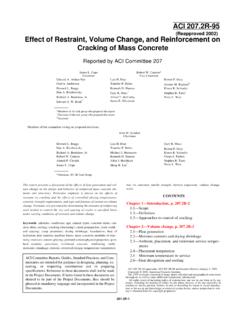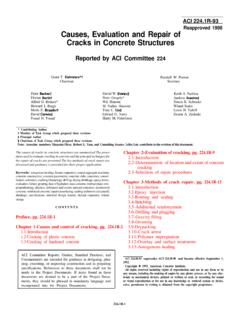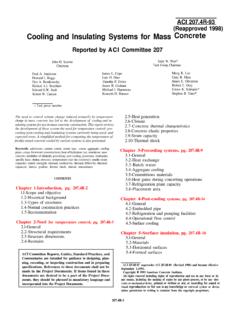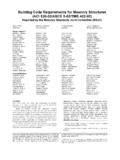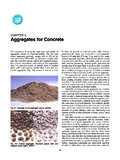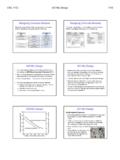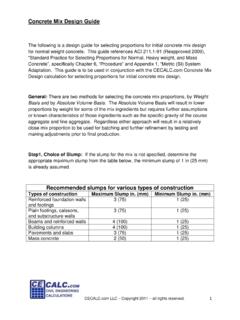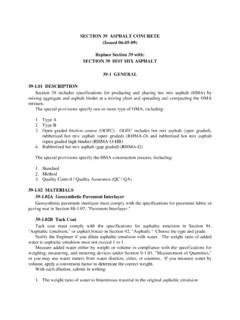Transcription of 211.2-98 Standard Practice for Selecting …
1 ACI supersedes ACI and became effective March 1, 1998, American concrete rights reserved including rights of reproduction and use in any form or by anymeans, including the making of copies by any photo process, or by electronic ormechanical device, printed, written, or oral, or recording for sound or visual reproduc-tion or for use in any knowledge or retrieval system or device, unless permission inwriting is obtained from the copyright proprietors. Practice for Selecting proportions for Structural Lightweight concrete (ACI ) Reported by ACI Committee 211 Jay R. PresteraSecretaryMichael BoyleChairmanDavid A. CrockerChairman, Subcommittee BEdward A. Abdun-NurStanley G. Barton*Leonard W. BellGeorge R. U. BergStanley J. Blas, M. CarrasquilloRamon L. CarrasquilloMartyn T. ConreyJames E.
2 CookRussell A. Cook*William A. CordonWayne J. CostaKenneth W. DayCalvin L. Dodl*Donald E. GrahamGeorge W. Hollon*William W. Hotaling, S. JenkinsPaul KliegerFrank J. LahmStanley H. LeeGary R. MassRichard C. MeiningerRichard W. NarvaLeo P. NicholsonJames E. OliversonJames S. PierceSandor PopovicsSteven A. RaganHarry C. RobinsonJere H. RoseJames A. ScherocmanJames M. Shilstone, B. SouthworthAlfred B. SpamerPaul R. Stodola*Michael A. TaylorStanley J. Virgalitte*William H. VoelkerJack W. WeberDean J. White, IIMilton H. Wills, C. WilsonRobert L. Yuan*Members of Subcommittee B who prepared this moisture content, aggregate proportions , cement con-tent, slump and/or air : absorption; adsorption; aggregate gradation; air content; airentrainment; cement content; coarse aggregates; fine aggregates; finenessmodulus; lightweight aggregate concretes; lightweight aggregates; mixproportioning; moisture; sampling; slump test; specific gravity factor;testing; 1 Introduction, p.
3 ScopeChapter 2 Factors affecting proportioning of lightweight aggregate concrete , p. Aggregates (Absorption and moisture content) Aggregates (Gradation) Water-cement Air entrainmentDescribes, with examples, two methods for proportioning andadjusting proportions of structural grade concrete containinglightweight aggregates. The weight (pycnometer) method uses aspecific gravity factor determined by a displacement pycnometertest on the aggregates (Method 1). The weight method alsoemploys the specific gravity factor to estimate the weight per yd3 ofthe fresh concrete . The damp, loose volume method uses thecement content-strength relationship for the design of all light-weight and sand lightweight concretes (Method 2). Examples aregiven for systematic calculation of batch weights, effective dis-placed volumes, and adjustment to compensate for changes inACI Committee Reports, Guides, Standard practices , andCommentaries are intended for guidance in planning, de-signing, executing, and inspecting construction.
4 This doc-ument is intended for the use of individuals who arecompetent to evaluate the significance and limitationsof its content and recommendations and who will ac-cept responsibility for the application of the material itcontains. The American concrete Institute disclaims anyand all responsibility for the stated principles. The Instituteshall not be liable for any loss or damage arising to this document shall not be made in con-tract documents. If items found in this document are de-sired by the Architect/Engineer to be a part of the contractdocuments, they shall be restated in mandatory languagefor incorporation by the Standard Practice 3 Estimating first trial mixture proportions , p. Method 1: Weight method (specific gravity pycnometer) Method 2: Volumetric method (damp, loose volume)Chapter 4 Adjusting mixture proportions ,p.
5 General Method 1: Weight method (specific gravity pycnometer) Method 2: Volumetric method (damp, loose volume) Adjustment Controlling proportions in the fieldChapter 5 References, p. Specified and/or recommended Cited referencesAppendix A Determination of specific gravity factors of structural lightweight aggregate,p. B Determination of structural lightweight coarse aggregate absorption,p. C Metric system adaptation, p. 1 PurposeThe purpose of this Standard is to provide generally appli-cable methods for Selecting and adjusting mixture propor-tions for structural lightweight concrete . These methods arealso applicable to concretes containing a combination oflightweight and normal weight ScopeDiscussion in this Standard is limited to structural grade,lightweight aggregates, and structural lightweight aggregateconcretes.
6 Structural lightweight aggregate concrete is de-fined as concrete which: (a) is made with lightweight aggre-gates conforming to ASTM C 330, (b) has a compressivestrength in excess of 2500 psi at 28 days of age when testedin accordance with methods stated in ASTM C 330, and (c)has an air dry weight not exceeding 115 lb/ft3 as determinedby ASTM C 567. concrete in which a portion of the light-weight aggregate is replaced by normal weight aggregate iswithin the scope of this Standard . When normal weight fineaggregate is used, it should conform to the requirements ofASTM C 33. The use of pozzolanic and chemical admixturesis not covered in this Standard . CHAPTER 2 FACTORS AFFECTING PROPORTIONING OF LIGHTWEIGHTAGGREGATE Aggregates (Absorption and moisture content) The principal factors necessitating modification of pro-portioning and control procedures for lightweight aggregateconcrete, compared to normal weight concrete , are the great-er absorptions and the higher rates of absorption of mostlightweight Damp aggregates are preferable to dry aggregates attime of mixing, as they tend to absorb less water during mix-ing and therefore reduce the possibility of loss of slump asthe concrete is being mixed, transported, and placed.
7 Dampaggregates have less tendency to segregate in storage. Ab-sorbed water is accounted for in the When concrete is made with lightweight aggregatesthat have low initial moisture contents (usually less than 8 to10 percent) and relatively high rates of absorption, it may bedesirable to mix the aggregates with one-half to two-thirds ofthe mixing water for a short period prior to the addition of ce-ment, admixtures and air-entraining admixture to minimizeslump loss. The supplier of the particular aggregate shouldbe consulted regarding the necessity for such predampeningand for mixing concrete made with saturated lightweight aggre-gates may be more vulnerable to freezing and thawing thanconcrete made with damp or dry lightweight aggregates, un-less the concrete is allowed to lose its excess moisture aftercuring, prior to such exposure, and has developed adequatestrength to resist When producing trial batches in the laboratory usingthe specific gravity method, the specific gravity of the light-weight aggregate should be determined at the moisture con-tent anticipated prior to use.
8 For most concrete mixture proportions to be practi-cal, aggregate proportions should be listed at a moisture con-dition readily attainable in the laboratory and in the field. Instructural lightweight concrete the main problem is account-ing properly for the moisture in (absorbed), and on (ad-sorbed), the lightweight aggregate particles as well as for theeffects of absorption for a specific application. Traditionally, concrete technologists have assumed, for aggregate moisturecontent correction purposes, that aggregates are in one of thefour conditions at the time of use. These four conditions areshown in Fig. (a).Fig. (a) States of moisture in aggregate. proportions FOR STRUCTURAL LIGHTWEIGHT CONCRETEMost concrete mixture proportions are reported with ag-gregates in either saturated, surface-dry (SSD) condition oroven-dry (OD) condition.
9 But in the field, aggregates areusually in the air-dry (AD) or wet condition. However, light-weight aggregate usually presents a unique situation. Moststructural lightweight aggregate concrete mixture propor-tions are reported in the oven-dry condition. However, in thefield they are not SSD, but in a damp or wet condition. Thiscondition is usually achieved by sprinkling, soaking, ther-mal quenching, or vacuum saturation. The result is some-times referred to as the as-is condition, [Fig. (b)].The main problem for the concrete technologist is to havean easy method of using field data to convert the oven-drylaboratory trial proportions to proportions in the as-is moisture Aggregates (Gradation) Grading of the fine and coarse aggregates and theproportions used have an important effect on the concrete .
10 Awell-graded aggregate will have a continuous distribution ofparticle sizes producing a minimum void content and will re-quire a minimum amount of cement paste to fill the will result in the most economical use of cement andwill provide maximum strength with minimum volumechange due to drying In general, the largest total volume of aggregate inthe concrete is achieved: (a) when the coarse aggregate iswell-graded from the largest to the smallest sizes; (b) whenthe particle is rounded to cubical in shape; and (c) when thesurface texture is least porous. Conversely, concrete con-taining coarse aggregates that tend to be angular in shape,more porous in surface texture, and possibly deficient inone or more particle sizes, will require a smaller volumeof same factors of grading, particle shape, and tex-ture also affect the percentage of fine aggregate requiredwith a minimum percentage of fine aggregate being asso-ciated with a rounded or cubical shape and smooth is common that when a well-graded, normal weight sandis used to replace lightweight fine aggregate, the propor-tion of coarse lightweight aggregate may be increased.
